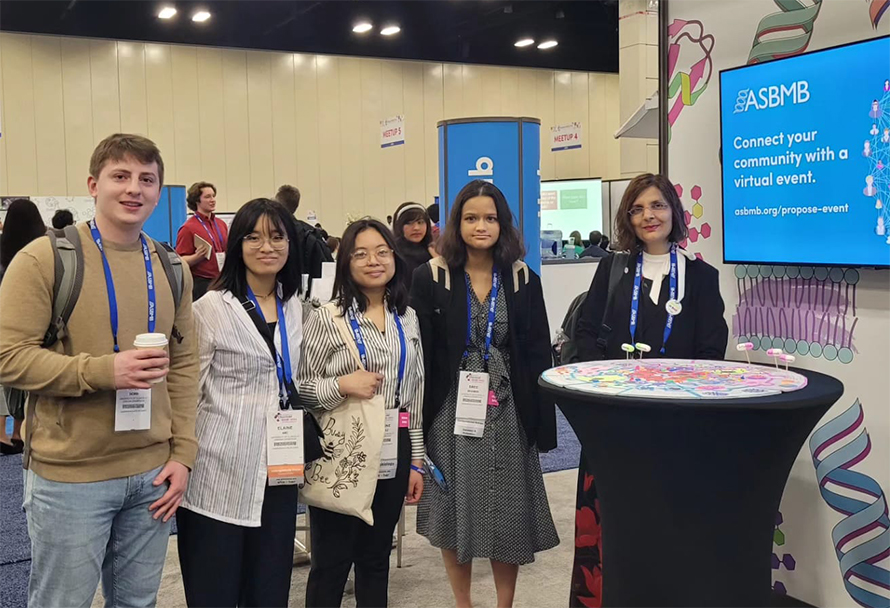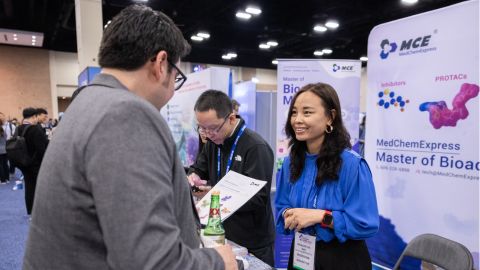A cellular jigsaw puzzle
As an educator, I often find myself visualizing concepts to aid in teaching. This propensity led me to conceive a novel idea while preparing to present a pedagogical poster at DiscoverBMB in San Antonio this year. Inspired by the opportunity to meet fellow biochemistry and molecular biology educators, I created a tangible representation of the immune microenvironment of tumors — a large puzzle.
In the study of cancer biology, students encounter the hallmark trait of cancer cells: their ability to replicate limitlessly. Why does a cell adopt such a strategy? What drives the unbridled proliferation of cell division? Does cancer manifest suddenly, overnight?

While this field remains a hotbed of research with myriad perspectives, one fact is clear: These cells are under stress, and their response to this stress leads them to stray from their original purpose, turning them selfish so they monopolize all available resources for their own ends. Unlike healthy cells in the body, cancer cells lose the ability to cooperate and share resources.
When confronted with stress signals, cells initially attempt self-repair. However, if the damage proves irreparable, apoptosis may occur. If the damaged cell persists, it enters a process of reprogramming and endeavors to bolster its resilience through metaplasia, even altering its identity. For instance, an original squamous epithelium may transform into stratified columnar epithelium. This adaptation serves as the cell’s response to stress. But, what if this adaptive strategy fails?
Persistent stress may lead to dysplasia, fortifying the cell’s strength and resilience. Up to this point, reversibility remains possible. The cell remembers its original state and function, and can revert once the stressors are removed. Yet, in cases of prolonged stress, the cell may lose this memory. Transitioning into a neoplastic state where survival becomes paramount, it disregards the suffering of neighboring cells.
When immune cells engage with these neoplastic cells, their primary objective is to eliminate them, safeguarding the overall system. However, over time, the neoplastic cells evolve to manipulate the immune system, reprogramming immune cells to serve their agenda. This manipulation involves a change in identity among immune cells; for instance, tumor-associated macrophages transition from an M1 to an M2 phenotype, tumor-associated neutrophils shift from an N1 to an N2 state, dendritic cells transform into tolerogenic DCs and cancer-associated fibroblasts lose their original roles.
Within the intricate milieu of the tumor microenvironment, neoplastic cells, mesenchymal cells and immune cells communicate with each other, influencing the course of cancer progression. The unique characteristics of these cell types not only define the malignant phenotype but also govern responses to chemotherapy and impact antitumor immunity. Tumor cells modulate this cellular dialogue with neighboring nonmalignant tissues, downregulating growth-inhibitory proteins while upregulating those that promote proliferation and survival.
Understanding these interactions can pose a significant challenge due to the complexity of the cellular receptors, their subunits, and the intricate interplay within signaling cascades, particularly within the realm of medical biochemistry.
On my journey to the U.S., I carried the supplies needed to construct a model that would represent these complexities. Over two nights in a hotel, I created my puzzle using foaming clay, markers and modeling sheets cut into jigsaw pieces — thus shaping my mental image into reality.
The puzzle, a circle with two distinct semicircles, serves as a visual metaphor for the dichotomy within the tumor microenvironment. The division is symbolized by two contrasting colors along the borders of the jigsaw pieces. Blue hues represent the environment of a healthy immune system, actively combating cancer, while pink shades illustrate the reprogrammed immune response favoring the tumor.
At the heart of this puzzle lies the essence of preserving receptor interactions; as individual jigsaw pieces merge, so too do the cellular receptors, enabling a dynamic visualization of their ongoing communication. Adding to the intrigue, immunotherapy drugs take the form of capsules strategically inserted at precise sites of action within the puzzle, amplifying the complexity and potential efficacy of treatment interventions.
I am grateful to the American Society for Biochemistry and Molecular Biology and its president, Ann Stock, for showcasing my model at the ASBMB booth. It was immensely gratifying to share this innovative educational tool with fellow educators and enthusiastic undergraduates, fostering engaging discussions and promoting a deeper understanding of tumor microenvironment dynamics.

Enjoy reading ASBMB Today?
Become a member to receive the print edition four times a year and the digital edition monthly.
Learn moreGet the latest from ASBMB Today
Enter your email address, and we’ll send you a weekly email with recent articles, interviews and more.
Latest in Opinions
Opinions highlights or most popular articles

Embrace your neurodivergence and flourish in college
This guide offers practical advice on setting yourself up for success — learn how to leverage campus resources, work with professors and embrace your strengths.

Survival tools for a neurodivergent brain in academia
Working in academia is hard, and being neurodivergent makes it harder. Here are a few tools that may help, from a Ph.D. student with ADHD.

Hidden strengths of an autistic scientist
Navigating the world of scientific research as an autistic scientist comes with unique challenges —microaggressions, communication hurdles and the constant pressure to conform to social norms, postbaccalaureate student Taylor Stolberg writes.

Black excellence in biotech: Shaping the future of an industry
This Black History Month, we highlight the impact of DEI initiatives, trailblazing scientists and industry leaders working to create a more inclusive and scientific community. Discover how you can be part of the movement.

Attend ASBMB’s career and education fair
Attending the ASBMB career and education fair is a great way to explore new opportunities, make valuable connections and gain insights into potential career paths.

Benefits of attending a large scientific conference
Researchers have a lot of choices when it comes to conferences and symposia. A large conference like the ASBMB Annual Meeting offers myriad opportunities, such as poster sessions, top research talks, social events, workshops, vendor booths and more.

